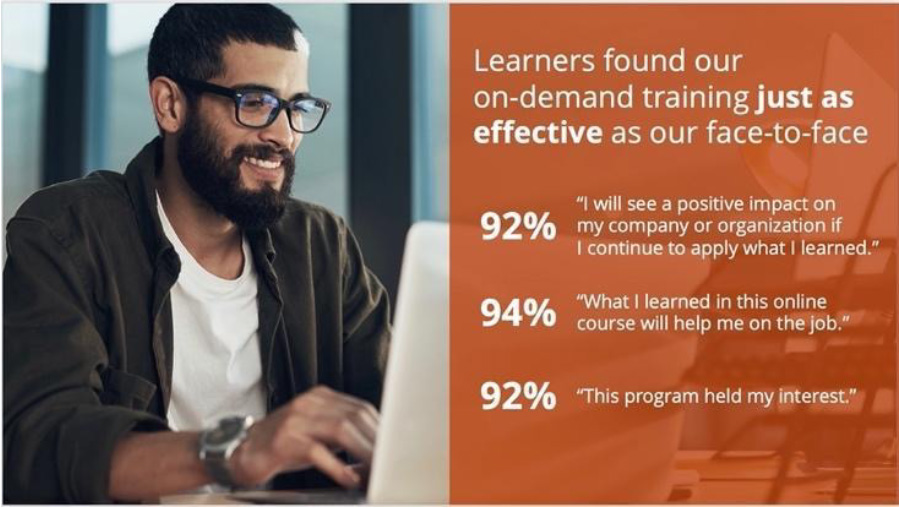If you feel like life demands too much of you, you’re not alone. According to one 2020 study, 60% of Americans feel “significant daily stress.” One contributing factor is time: Many people feel they simply don’t have enough of it. Amid these challenges, it’s easy to see how professional training can be difficult to prioritize, but learning new skills is no less critical to an individual or company’s success.
Read on to learn about TPC’s process for ensuring engagement in on-demand learning programs, and get six practical tips for how you can break through the stress and noise of daily life to provide high-quality training to your employees.
 eLearning: Time for an Evolution?
eLearning: Time for an Evolution?
Despite the promise that on-demand eLearning provides a flexible and scalable training solution for large organizations, in practice… it typically doesn’t go as planned. Oftentimes, people don’t complete their online courses, and for those that do, there’s a question brewing in the L&D community about whether or not this type of training has the same impact and stickiness as live, instructor-led training.
At the same time, there’s been growing development around the idea of “social, collaborative online learning”, and technology platforms being developed that attempt to replicate the behavior change that instructor-led workshops generate. Central to this shift was a growing observation that perhaps current online learning solutions had over-indexed on technology. In the industry’s effort to scale and automate… did we lose sight of the human taking the course, and the emotional needs that adult learners have when it comes to learning, engagement, and retention of workplace training?
 The Power Thruple: Facebook + NovoEd + TPC
The Power Thruple: Facebook + NovoEd + TPC
In 2017, we set out to create a new type of on-demand training program that would be social, collaborative, flexible, and, most importantly, compelling. The program we envisioned would be online and asynchronous, but still deliver rich opportunities for collaboration and connection among a community of learners. To create the training program we envisioned, we needed to lean on our network of experts.
We started with a longtime client, Facebook, as our client partner. As a global company with offices worldwide in the fast-paced and ever-changing technology industry, Facebook strives to provide professional training that is scalable and easy to administer to its employees across multiple regions to ensure each individual develops the skills needed for the business to succeed. Facebook’s openness to exploring and developing cutting-edge learning solutions proved to be an invaluable asset in developing this training program, and for the first iterations of our program together, Facebook employees served as beta participants.
NovoEd
With an emphasis on encouraging authentic engagement, NovoEd’s learning platform was the ideal delivery mechanism for our on-demand training program. NovoEd specializes in creating a collaborative online experience that features guided social interaction. These interactions boost engagement and outcomes for participants and achieves comparable results to in-person training.
TPC
With Facebook and NovoEd as our committed partners, TPC’s expertise in human-centric storytelling allowed us to create a highly engaging learning experience for participants that turned out to be just as effective as the in-person and live virtual training we have conducted for years.
 Grappling with the challenges of traditional programs
Grappling with the challenges of traditional programs
With an abundance of questions ahead of us, we needed to grapple with several challenges when it comes to traditional online training programs:
- Online training programs are perceived as boring and difficult to complete.
Our response? Create a program that’s engaging and helps participants feel as if they want to complete the training. - It’s difficult to foster collaboration in traditional eLearning, meaning participants rarely learn from one another.
Our response? Make our program genuinely collaborative and award points for giving peer feedback. - Managers often feel disconnected from online training programs, and organizations struggle to integrate their leadership into learning environments that happen remotely.
Our response? Develop a truly integrated program that permeates and benefits an entire organization. - L&D worries that digital learning programs don’t work, and that learning doesn’t stick with participants… especially with remote workers.
Our response? Design a program that shares qualities of our in-person and virtual training to create a lasting, positive impact on participants.
 We built it. They came (in droves). So how does it work?
We built it. They came (in droves). So how does it work?
Our on-demand storytelling program places participants in cohorts of 30, 60, or 90, and includes a ten-day active learning journey broken into four modules, plus one optional “bonus” module. Following the ten-day active learning period, course materials are available to participants for an additional 80 days.
 A seamless, integrated experience
A seamless, integrated experience
Unlike traditional eLearning that’s often composed as a patchwork of videos, discussion, and other features that were not designed to be gathered into one course, this course features an intuitive interface where videos, discussion boards, quizzes, assignments, and the ability to tag classmates for feedback are all central components.
This approach to on-demand learning creates a seamless experience for participants, ultimately contributing to the stickiness of the training and encouraging higher levels of authentic engagement.
“We wanted to create a place that is natural, intuitive, and safe for people to exchange ideas, give and receive feedback, and ask questions.” — Charlie Chang, VP of Business Development at NovoEd

Six key lessons we learned from this experience
- Put people at the center of course design
Even with the best technology, we can’t lose sight of the people at the center consuming the learning. We learned that creating a video culture with high-quality, humanized content generates the best results. Videos featured real TPC facilitators — real humans telling stories — who are deeply familiar with the content.
Creating a video culture contributed to the course’s 95% engagement rate. When we say that there was a 95% engagement rate in the course, that means 95% of learners not only completed the course, but went above and beyond the minimum requirements!

- Human coaches can make all the difference
One of our big “aha!” moments came when we inserted a real live Learning Community Manager into the flow of learning. Participants used them as a guide through the program, a sounding board, and an encouraging voice to collaborate with peers.
The Learning Community Manager can also provide a personal nudge from time to time to keep things moving along.The Learning Community Manager, who we call the “professional cheerleader,” was a smash hit. In fact, adding the Learning Community Manager to the course drove participant feedback on peer assignments up by 5X!
- Make it flexible — but not unstructured
People want flexibility in their learning opportunities. But we needed to determine exactly what kind of flexibility is most desirable. We learned that the most important element of flexibility is time. We also learned that people thrive on having a schedule. In other words, people want to consume learning at their pace but within a loosely prescribed timeframe. So, asynchronous courses work best when accompanied by clear deadlines for each milestone.
One problem with traditional eLearning is that it’s linear and overly prescriptive. We sought to find the perfect balance of flexibility and rigidity. Participants can take their own path in completing course content — the entire course (except for the last module with bonus content) is available to everyone from the first day of the course. As a result, learners can work through the course content in whatever order works for them.
However, we do provide a recommended sequence for course content. We learned that participants prefer this kind of guidance: 97% consumed the learning in the recommended order, even though they didn’t have to. Why? We found it’s because asking learners to choose places the burden on them. Providing the flexibility of choice can be valuable to some, but a recommended sequence and timeline is ideal, mainly because those following the sequence can interact as they work through content, generally at the same time, together.

- People learn better together — so let them
Research backs up the notion that learning together helps foster a sense of belonging, and a deeper level of learning and engagement. Collaborative learning helps employees practice and apply new skills, promotes discussion and feedback, enables team-based learning across an organization, and engages managers and mentors. The social element of our course, utilized with integrated collaboration tools built right into the interface, encouraged 100% of the participants to engage in peer discussions.
- Motivate and communicate to get learners to show up and stay engaged
We learned a few strategies to ensure that learners stay engaged throughout the course:
- Use communications channels we know people are using. Features such as email and tagging comments make communication easy and intuitive by leveraging experience learners are already accustomed to.
- Celebrate milestones along the way. We know that recognition increases engagement in the workplace, and we observed a similar trend in this course as well.
- Use automated personalized communications that are sent as people work through the program. We learned that reminders are needed to help people stay on track throughout the course. These communications are personalized and related to the individual’s progress on specific assignments. These strategies are effective and scalable because communications are personalized and automated. They also help participants prioritize the training amid everything else going on in their lives.
- Leverage gamification to encourage participation. By gamifying the course, we capitalize on humans being hard-wired to compete. To complete the course, participants must earn 700 points, which they can collect in a variety ways, such as watching videos, passing knowledge checks, participating in discussions, and completing a final survey. At any point during the program, participants can view a leaderboard to see how their progress compares to others in their cohort.
- Done is better than perfect
Lining the walls at Facebook’s offices are posters challenging everyone to think differently. One that inspired us at TPC says, “Done is Better than Perfect.” It means our best ideas and products need to come to life in the real world in order for us to learn how to make them better. It’s about taking risks and being okay that our output might not be completely perfect, that it’s a work-in-progress, and success comes through iteration (and lots of listening to our audience).
For example, because engagement was our goal, in the development of this course, we specifically tested for participant engagement and iterated in response to what we learned. For instance, we experimented with using live speakers in the course and found that it wasn’t as engaging because it removed an element of flexibility for learners. Instead, we learned that asynchronous work, where high-quality video content was a central component, was the most engaging for learners.

 Never lose sight of the humans behind the screen
Never lose sight of the humans behind the screen
We learned that, when partnering with companies like Facebook and NovoEd, the right application of technology can create an impactful online learning experience that meets the needs of learners in an increasingly digital world where hybrid work environments are the new normal.
But as good as it is, at the core of any great training program is people and our innate craving for connection and community. It’s how we build trust with one another. So as you think about how on-demand training fits into your learning journeys, let’s not forget the humans at the center of it all.


